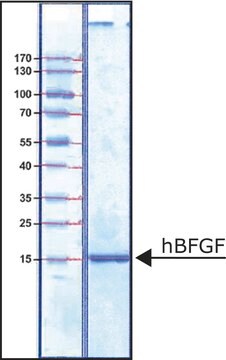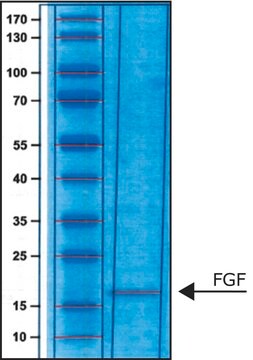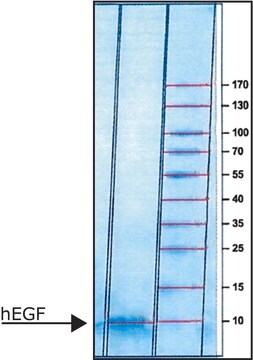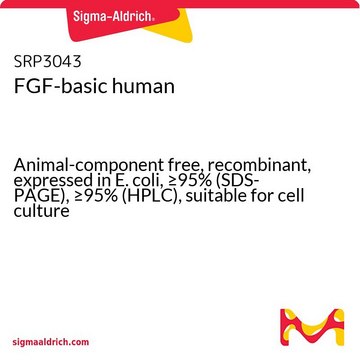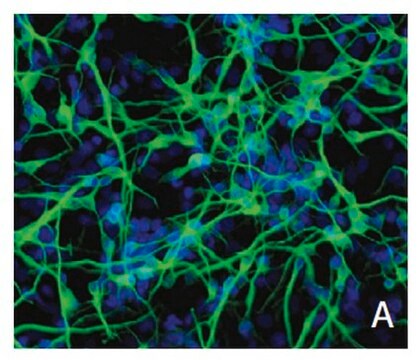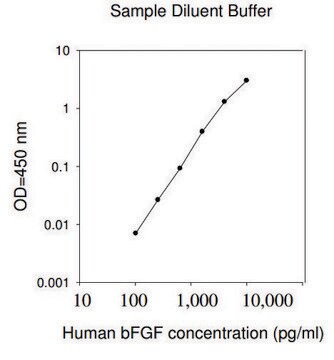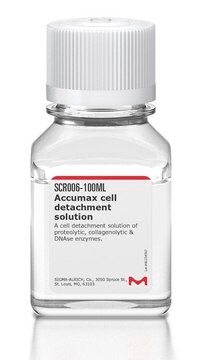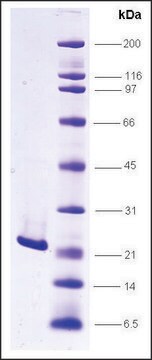GF003AF
Fibroblast Growth Factor basic, human
Animal free, >95% (SDS-PAGE), recombinant, expressed in E. coli, suitable for cell culture
Sinonimo/i:
FGF-2, bFGF, basic-FGF, Heparin-Binding Growth Factor 2, Prostatropin
About This Item
Prodotti consigliati
product name
Fibroblast Growth Factor basic, human recombinant, animal-free, The Fibroblast Growth Factor-basic (or bFGF protein) is a heparin binding growth factor which stimulates the proliferation of a wide variety of cells including mesenchymal, neuroectodermal & endothelial cells.
Origine biologica
human
Livello qualitativo
Saggio
>95% (SDS-PAGE)
Produttore/marchio commerciale
Chemicon®
tecniche
cell culture | stem cell: suitable
Impurezze
<0.1 EU/μg Endotoxin (of bFGF)
input
sample type epithelial cells
sample type mesenchymal stem cell(s)
sample type: human embryonic stem cell(s)
sample type neural stem cell(s)
sample type pancreatic stem cell(s)
N° accesso NCBI
N° accesso UniProt
Descrizione generale
Applicazioni
Stato fisico
Stoccaggio e stabilità
General applications:
After a quick spin, reconstitute in 0.1M phosphate buffer, pH 6.8, to a concentration of 0.1-1.0 mg/mL. Reconstituted bFGF should be stored in working aliquots at -20°C for up to six months. Multiple freeze/thaw cycles will result in significant loss of activity.
For Human ES cell culture:
After a quick spin, reconstitute to 10 μg/mL in a filtered solution of 0.5% BSA, 1 mM DTT, and 10% glycerol in Dulbecco′s PBS. Aliquot and store at -20°C for up to six months. This solution can then thawed and diluted to 4 ng/mL for the culture of human ES cells with a feeder layer, or to 8 ng/mL to supplement mouse embryonic fibroblast-conditioned medium (for feeder-free human ES cell culture).
Risultati analitici
Note legali
Esclusione di responsabilità
Codice della classe di stoccaggio
11 - Combustible Solids
Classe di pericolosità dell'acqua (WGK)
WGK 3
Certificati d'analisi (COA)
Cerca il Certificati d'analisi (COA) digitando il numero di lotto/batch corrispondente. I numeri di lotto o di batch sono stampati sull'etichetta dei prodotti dopo la parola ‘Lotto’ o ‘Batch’.
Possiedi già questo prodotto?
I documenti relativi ai prodotti acquistati recentemente sono disponibili nell’Archivio dei documenti.
I clienti hanno visto anche
Articoli
Fibroblast growth factors in cell culture and various growth factors for your research
Il team dei nostri ricercatori vanta grande esperienza in tutte le aree della ricerca quali Life Science, scienza dei materiali, sintesi chimica, cromatografia, discipline analitiche, ecc..
Contatta l'Assistenza Tecnica.
